Ditapis dengan
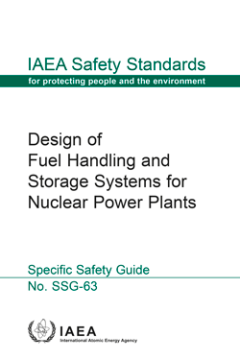
Design of Fuel Handling and Storage Systems for Nuclear Power Plants - IAEA S…
This Safety Guide provides recommendations on how to meet the requirements of IAEA Safety Standards Series No. SSR-2/1 (Rev. 1), Safety of Nuclear Power Plants: Design, in relation to fuel handling and storage systems. The publication addresses the design aspects of handling and storage systems for fuel that remain part of the operational activities of a nuclear reactor. It covers the following…
- Edisi
- -
- ISBN/ISSN
- 978-92-0-108519-1
- Deskripsi Fisik
- 53 pages, 134 MB
- Judul Seri
- -
- No. Panggil
- -

Computer Security Aspects of Design for Instrumentation and Control Systems a…
The transition to digital technology has changed the nature of instrumentation and control (l&C) systems by enabling extensive interconnection of reprogrammable, functionally interdependent I&C systems. This development has made computer security a necessary element for consideration in I&C system design. The benefits and challenges of the various computer security methods and controls with the…
- Edisi
- -
- ISBN/ISSN
- 978-92-0-104919-3
- Deskripsi Fisik
- 57 Pages
- Judul Seri
- -
- No. Panggil
- -

Climate Change and the Role of Nuclear Power - Proceedings of an Internationa…
To address the challenges posed by climate change, and to achieve the goals established in the 2015 Paris Agreement, nuclear power has been identified to have great potential to contribute to the 1.5°C climate change mitigation target. This topical conference on climate change and the role of nuclear power, the first of its kind, served as a unique forum for exchanging science-based informatio…
- Edisi
- -
- ISBN/ISSN
- 978-92-0-120120-1
- Deskripsi Fisik
- 218 Hal
- Judul Seri
- -
- No. Panggil
- -

Design of the Reactor Containment Systems in Nuclear Power Plants, A Safety G…
Safety requirements for the design of containment systems are presented in a generic form. The various functions of confinement, isolation, energy management, radionuclide management and combustible gas control as well as the structural and leak integrity are covered. Annexes provide examples for the most common design solutions and other aspects.
- Edisi
- -
- ISBN/ISSN
- 9201237855
- Deskripsi Fisik
- 68 p. : Illus. ; 24 cm
- Judul Seri
- Safety Series No. 50–SG–D12
- No. Panggil
- 621.48 IAE d

Ultimate Heat Sink and Directly Associated Heat Transport Systems for Nuclear…
This book consist : Introduction; Design principles; Postulated initiating events; and Design features. (Jml)
- Edisi
- -
- ISBN/ISSN
- 920123581X
- Deskripsi Fisik
- 62 p. : Illus. ; 24 cm
- Judul Seri
- Safety Series No. 50-SG-D6
- No. Panggil
- -
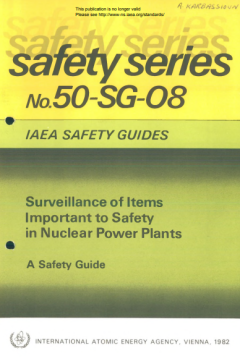
Safety Series No.50-SG-08.Surveillance of items Importment to Safety in Nucle…
This Safety Guide provides guidance and recom m endations on surveillance activities to ensure that structures, systems and com ponents im portant to safety are available to perform their functions in accordance w ith design intent and assumptions. The Guide was prepared as part of the IAEA’s programme, referred to as the NUSS Programme, for establishing Codes of Practice and Safety Guides re…
- Edisi
- -
- ISBN/ISSN
- -
- Deskripsi Fisik
- -
- Judul Seri
- -
- No. Panggil
- -
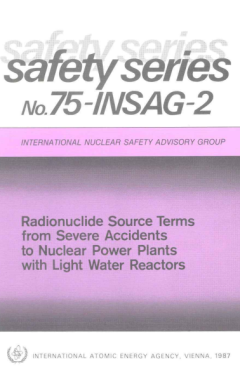
Safety Series No.75-INSAG-2 Radionuclide Source Terms From Severe Accidents t…
Nuclear power plants of the light water reactor (LWR) type are so designed and operated that no accident reasonably considered to be possible would release significant amounts of fission products to the environment. It follows that rare improbable events such as severe accidents would provide the only potentially significant contribution to adverse human health effects. The potential for such s…
- Edisi
- -
- ISBN/ISSN
- -
- Deskripsi Fisik
- -
- Judul Seri
- -
- No. Panggil
- -
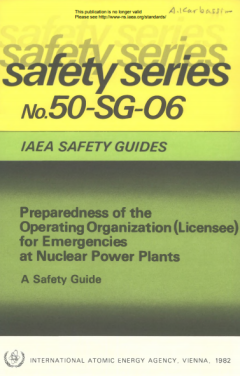
IAEA Safety Guides.Safety Series No.50-SG-06.Preparedness of the Operating Or…
This Safety Guide was prepared as part of the Agency’s programme, referred to as the NUSS programme, for establishing Codes o f Practice and Safety Guides relating to nuclear power plants. It supplements the Code of Practice on Safety in Nuclear Power Plant Operation, including Commissioning and Decommissioning (IAEA Safety Series No. 50-C-0), hereinafter referred to as the Code. The Provisio…
- Edisi
- -
- ISBN/ISSN
- -
- Deskripsi Fisik
- -
- Judul Seri
- -
- No. Panggil
- -
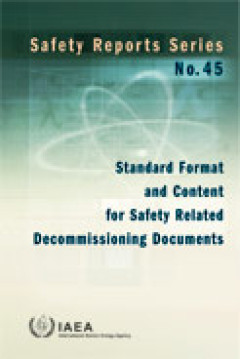
Standards Format and Content for Safety Related Decommisioning Document
This report provides information on the content and format for decommissioning plans and supporting safety related documents. Its scope includes information that is relevant to all types of nuclear facilities, ranging from nuclear power plants and reprocessing facilities to university laboratories and manufacturing plants. The report will be of interest to decommissioning planning engineers, pr…
- Edisi
- -
- ISBN/ISSN
- -
- Deskripsi Fisik
- 64 p. : Illus. ; 24 cm
- Judul Seri
- Safety Reports Series No. 45
- No. Panggil
- -
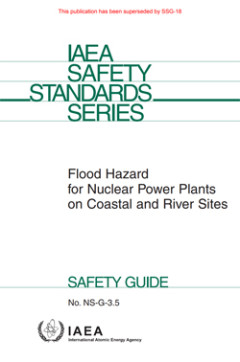
Flood Hazard for Nuclear Power Plants on Coastal and River Sites
This Safety Guide discusses the phenomena, both natural and human induced, that may cause floods or droughts at coastal and river sites, and gives an outline of the methods that can be used for, and the critical factors involved in, the evaluation of such events and of their associated effects. Possible combinations of two or more phenomena that can give rise to flooding at a site are also disc…
- Edisi
- -
- ISBN/ISSN
- -
- Deskripsi Fisik
- 83 p. : illus. ; 29,5 cm
- Judul Seri
- Safety Standards Series No. NS-G-3.5
- No. Panggil
- 621.48 IAE f
 Karya Umum
Karya Umum  Filsafat
Filsafat  Agama
Agama  Ilmu-ilmu Sosial
Ilmu-ilmu Sosial  Bahasa
Bahasa  Ilmu-ilmu Murni
Ilmu-ilmu Murni  Ilmu-ilmu Terapan
Ilmu-ilmu Terapan  Kesenian, Hiburan, dan Olahraga
Kesenian, Hiburan, dan Olahraga  Kesusastraan
Kesusastraan  Geografi dan Sejarah
Geografi dan Sejarah